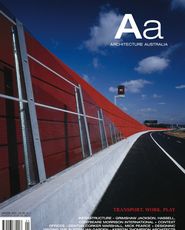ARCHITECTURAL SERVICES
What is architectural service? What should it comprise? How is this changing in the face of shifting procurement methods and developing technologies?
How does one negotiate potential tensions between design intentions, perceptions of design quality and client expectation? Does continually doing more than you are paid for help undermine the profession long-term, even though it might save a particular job and therefore seem to be “good service”?
Although unglamorous, these are key questions for the profession, particularly as the environment in which it operates continues to shift and change rapidly.
Last year I had the pleasure of being a juror for the Architects Registration Board of Victoria’s Architectural Services Award, an experience which made me think, once again, of the importance of such questions. Now in its third year, the ARBV award was established to recognize good architectural service, as distinct from the focus on high-end design outcomes that characterizes most other award programmes. The emphasis on service is a specific response to the kind of complaints received by the ARBV from the public, most of which concern things like “budget over-run, confusion and lack of communication, poor resolution of problems that occur during a project, lack of a client/architect agreement and documentation that is untimely or difficult to understand.” Through recognizing exceptional service, the ARBV hopes to promote better approaches to working with clients and their projects.
Architects are nominated for the Architectural Services Award by their clients, and each architect submits three projects, with a budget of less than $4M. Nominations are then assessed according to the architect’s “performance in providing information, communicating, managing of the project and handling of the contractual dealings.” Last year, the jury was impressed by glowing praise from the clients, both written and verbal. We spoke with six clients, all of whom had prior experience with the architectural profession. Each seemed delighted by their architects. After much deliberation, the jury made a joint award, partly to recognize excellence across the variety of services offered by architects – from Colcept’s complex construction management work for upgrading high-rise public housing to Neometro’s high-design bespoke houses.
However, with the exception of Colcept’s work for the Office of Housing, almost all of the entries were a variation on the traditional model of full architectural service, from design through to supervision. This model is the subject of most complaints to the ARBV, and may be still the most prevalent model of architectural service for works under $4M, but it is one which is under increasing pressure from all sides. The success of the ARBV award suggests that the profession could also explore ways of recognizing and assessing excellent architectural service in other kinds of environments. What is exceptional architectural service on a PPP project, or a design and construct one, or when the architect is novated to the builder, or when the architect is only commissioned to provide partial services on a smaller scale project?
What are the models for architectural service in the age of BIM? Should the concept of architectural service encompass the idea of service to the community (and the profession) as well as to the client? Examples of award-winning service in these contexts could also provide valuable models for the profession.
A number of the building reviews in this issue point to similar questions.
In their review of Brisbane Square, Haig Beck and Jackie Cooper point out the limitations of the standard commercial brief for even the most inventive and skilful architect. Peter Raisbeck’s commentary on Southern Cross Station discusses the importance of the architect to the successful outcomes of the PPP process. Of course not all building reviews and award programmes can engage fully with such issues, but it is vital that such topics be part of the discussion of architecture within the profession.
JUSTINE CLARK















